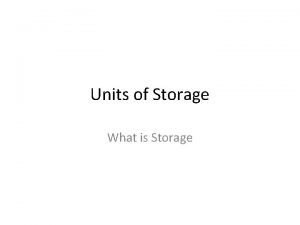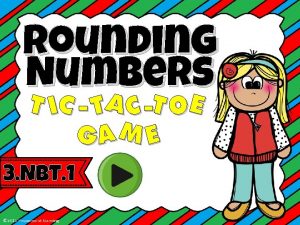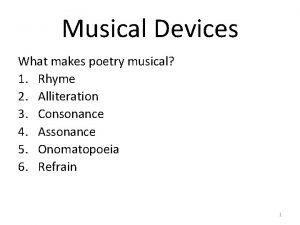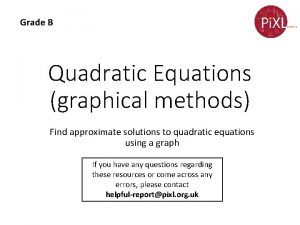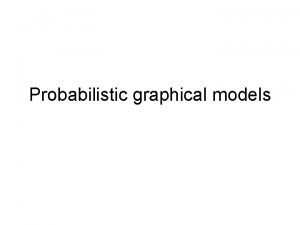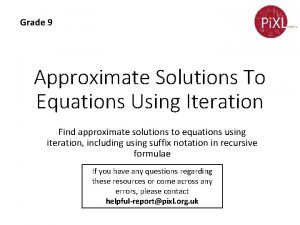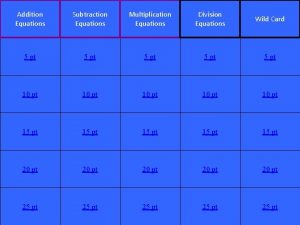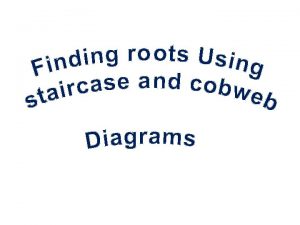Grade C Graphical solutions to equations Find approximate











- Slides: 11

Grade C Graphical solutions to equations Find approximate solutions to equations using a graph If you have any questions regarding these resources or come across any errors, please contact helpful-report@pixl. org. uk

Key Vocabulary Linear Equations Axis Solution Intersection Y-intercept Gradient

How to find solutions graphically 1) Find approximate solution to the equation 2 x + 1 = 3 x Draw the graphs of: y = 2 x + 1 y = 3 x y = 2 x+1 The y coordinate of this point can be found by looking at the graph, which is 3. Solution is where the two lines meet at approximately x=1

How to find solutions graphically 2) Find approximate solution to the equation x – 4 = -2 x + 3 Draw the graphs of: The y coordinate of this point can y= y= be found by looking at the graph, which is y=x– 4 approximately 1. 7 y = -2 x + 3 Solution is where the two lines meet at approximately x = 2. 3

How to find solutions graphically 3) Find approximate solution to the equation y = x 2 -5 x + 6 The solutions for x 2 -5 x + 6 = 0 are where y = 0. And the graph x 2 -5 x + 6 = 0 meet y=0 is the x-axis x=2 x=3 Therefore the solutions for x 2 -5 x + 6 = 0 are x = 2 and x = 3

How to find solutions graphically 4) Find approximate solution to the equation x 2 -5 x + 6 = 2 This is where the graph x 2 -5 x + 6 = 0 meets the line y=2 x=1 x=4 So the solutions for x 2 -5 x + 6 = 2 are x = 1 and x = 4 where the two lines intersect.

Finding solutions graphically – now you try. . . a) Find an approximate solution to the equation 3 x + 4 = 2 x by drawing graphs. Then find the y coordinate. b) Find an approximate solution to the equation 5 - 4 x = 2 x + 1 by drawing graphs. Then find the y coordinate. c) Find approximate solutions to the equation x 2 -2 x - 8 = 0 d) Find approximate solutions to the equation x 2 -2 x - 8 = 7 e) Find approximate solutions to the equation x 2 –x – 6 = 5

Finding solutions graphically – now you try. . . a) Find an approximate solution to the equation 3 x + 4 = 2 x by drawing graphs. Then find the y coordinate. x = -4, y = -8 b) Find an approximate solution to the equation 5 - 4 x = 2 x + 1 by drawing graphs. Then find the y coordinate. x = 0. 6, y = 2. 2 c) Find approximate solutions to the equation x 2 -2 x - 8 = 0 x = 4 and x = -2 d) Find approximate solutions to the equation x 2 -2 x - 8 = 7 x = 5 and x = -3 e) Find approximate solutions to the equation x 2 –x – 6 = 5 x = 3. 8 and x = -2. 8

Problem Solving and Reasoning a) Using the fact 1 inch is approximately equivalent to 5. 08 cm, create a conversion graph on a graph paper, clearly labelling the x and y axis. b) Using your conversion graph, convert 20 inches to cm. c) Using your conversion graph, convert 50 inches to cm. d) Using your conversion graph, convert 67 cm to inches.

Problem Solving and Reasoning Inches a) 70 60 50 40 30 20 10 How do I convert 100 inches to centimetres? 10 20 30 40 50 60 70 Centimetres b) Using your conversion graph, convert 20 inches to cm. 49. 5 – 51. 5 cm c) Using your conversion graph, convert 50 inches to cm. 126 – 128 cm d) Using your conversion graph, convert 67 cm to inches. 169. 5 – 171. 5 cm

Reason and explain When do we get approximate solutions and when do we get exact solutions? If we can approximate, why do we need exact solutions? Give examples of real life situations where exact solutions are required. Do conversion graphs always cross at (0, 0)?
 Find the solution
Find the solution Quadratic simultaneous equations
Quadratic simultaneous equations Metode gauss seidel
Metode gauss seidel What are storage device
What are storage device Approximate computing
Approximate computing Approximate 645 to the nearest hundred
Approximate 645 to the nearest hundred Definition of a narrative poem
Definition of a narrative poem The approximate dates of the baroque period in music are
The approximate dates of the baroque period in music are Musical devices in poetry
Musical devices in poetry Fast exact and approximate geodesics on meshes
Fast exact and approximate geodesics on meshes A building bent deflects in the same way as
A building bent deflects in the same way as A guided tour to approximate string matching
A guided tour to approximate string matching



